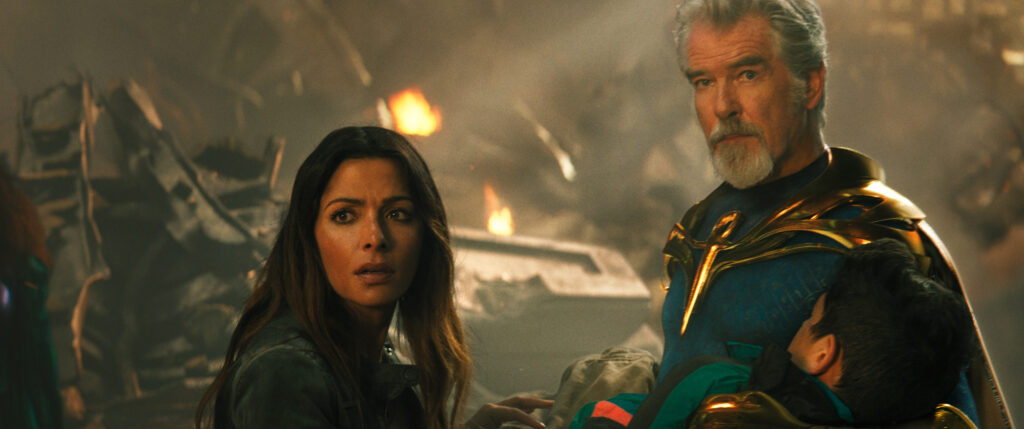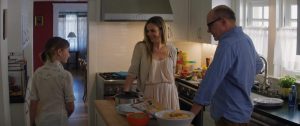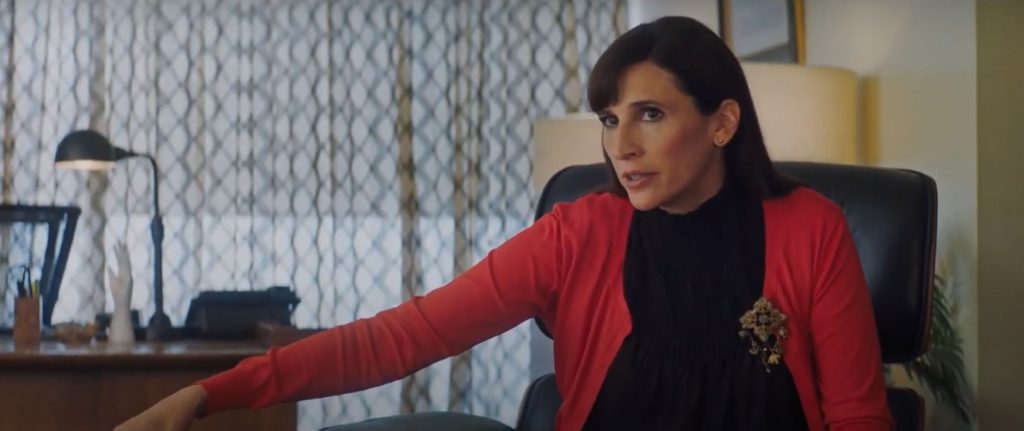October 19, 2022
by Carla Hay

Directed by Jaume Collet-Serra
Culture Representation: Taking place in the fictional nation of Kahndaq and briefly in Louisiana, the superhero action film “Black Adam” features a racially diverse cast of characters (white, Asian and African American) portraying superheroes and regular human beings.
Culture Clash: Reluctant superhero Teth Adam, later known as Black Adam, finds it difficult to change his vengeful and troublemaking ways, and he does battle against the Justice Society and a group of land pillagers called Intergang.
Culture Audience: “Black Adam” will appeal primarily to people who are fans of star Dwayne Johnson and movies based on DC Comics, but the movie is a disappointing and unimaginative cinematic origin story for Black Adam.

“Black Adam” is nothing more than a mishmash of big-budget superhero clichés with empty dialogue, atrocious editing, a forgettable villain and a lackluster story. You know it’s bad when the mid-credits scene is what people will talk about the most. “Black Adam” (which is based on DC Comics characters and stories) is the type of misguided mess that tries to do too much and ends up not making much of impact at all. It’s one of the weakest movies in the DC Extended Universe.
Directed by Jaume Collet-Serra, “Black Adam” could have been a thoroughly entertaining, epic superhero movie, based on the fact that charismatic Dwayne Johnson has the title role, and the movie has several talented cast members. (Johnson is also one of the movie’s producers.) But the “Black Adam” screenplay (written by Adam Sztykiel, Rory Haines and Sohrab Noshirvani) is a complete dud, with mindless conversations and stale jokes that look too forced.
It’s fair to say that people don’t watch superhero movies for super-intelligent dialogue, but even the action sequences in “Black Adam” are substandard. The visual effects are hit-and-miss and aren’t particularly impressive. And the choppy editing looks like something you might see in a beginner, low-budget film, not a movie that with experienced filmmakers and a bloated nine-figure production budget.
“Black Adam” begins in the year 2600 B.C. in the fictional kingdom of Kahndaq, which is supposed to be somewhere in the Middle East. The most valuable resource in Kahndaq is Eternium, which gives special magical powers to anyone in possession of Eternium. Needless to say, wars and crimes have been committed in the competition to get Eternium.
A mystical warrior named Teth Adam (played by Johnson), who has superpowers in strength and speed, is someone who experienced a tragedy as a result of this greed for Eternium. As a result, he went on vengeful crime sprees but was eventually imprisoned in the Rock of Eternity (which is a resource hub for magic), where he was entombed for 5,000 years. The legend of Teth Adam was passed on for generations.
In the present day, Kahndaq is now an economically struggling country that has been invaded by white Europeans looking to mine the land for Eternium. A villainous group called Intergang wreaks the most havoc in this quest for Eternium. Meanwhile, a group of rebel freedom fighters aiming to defeat Intergang will be hunted by members of Intergang.
What does this have to do with Black Adam? One of the leaders of the freedom fighters is named Adrianna Tomaz (played by Sarah Shahi), who ends up being captured with her brother Karim (played by Mo Amer), who is also a freedom fighter, while they are trying to get a magical crown. Their friend and colleague Ishmael (played by Marwan Kenzari) is also involved in tryng to get this crown.
While being held captive in a cave that ends up being where the Rock of Eternity is, Adrianna yells, “Shazam!” It’s the magical word that awakens Teth Adam, who breaks out of captivity from the tomb. Adrianna and Karim escape, but for a good deal of the movie, they are being chased by Intergang thugs. Will formerly imprisoned Adam help them?
Adrianna is a widowed mother of an adolsecent son named Amon Tomaz (played by Bodhi Sabongui), who’s about 13 or 14 years old. Without going into too many details, it’s enough to say that Teth Adam eventually meets Amon, Adrianna and Karim. Amon immediately is in awe of Adam, but Adam is less impressed with this family and doesn’t really want to get involved with the family’s Intergang problems, until certain circumstances lead Adam to be on the family’s side.
That entire storyline would be enough for one movie, but “Black Adam” crams in another storyline where Adam is at odds with a group of superheroes called Justice Society, which has reunited when it becomes known that Teth Adam is on the loose and causing damage again. Viola Davis has a cameo near the beginning of “Black Adam” to reprise her “Suicide Squad” character Amanda Waller, who makes a command that sets the Justice Society back in motion. There’s nothing special about any of the cast members’ acting, a lot of which looks “phoned in,” with no uniquely memorable flair.
The members of the Justice Society in the “Black Adam” movie are:
- Carter Hall/Hawkman (played by by Aldis Hodge), a loyal and earnest warrior who has lived for thousands of years and has the flying skills of a hawk.
- Kent Nelson/Doctor Fate (played by Pierce Brosnan), a kind-hearted and grandfatherly archeologist who has the powers of a sorcerer.
- Al Rothstein/Atom Smasher (played by Noah Centineo), a clumsy and goofy 20-year-old who can grow to the size of a skyscraper.
- Maxine Hunkel/Cyclone (played by Quintessa Swindell), a playful and courageous 19-year-old who has the power to use her mind to create cyclone-like gusts of wind.
Unfortunately, all of these Justice Society characters are written to have very generic personalities and extremely bland chemistry with each other. Maxine Hunkel/Cyclone in particular is very under-used and is more like a placeholder than an impactful, developed character. And some of the lines of dialogue they have to say are downright cringeworthy. More than once, Hawkman says to Doctor Fate: “A bad plan is better than no plan at all.” That sounds like the same attitude that the “Black Adam” filmmakers had in making this shoddy superhero movie.
Expect to see a lot of formulaic chase scenes, shootouts, explosions and all the usual stereotypes of superhero action flicks. “Black Adam” has some half-hearted preachiness about white colonialism in countries where most of the residents aren’t white, but this attempt to bring a “social consciousness” to “Black Adam” looks as phony as some of the movie’s often-unconvincing visual effects. Everything in the story is jumbled up and scatterbrained, as if the filmmakers couldn’t decide how to juggle the storylines of Adam being at odds with the Justice Society and Intergang. (The 2021 action flick “Jungle Cruise,” also directed by Collet-Serra and starring Johnson, had the same overstuffed story problem.)
Meanwhile, Teth Adam/Black Adam scowls and smashes his way throughout the movie like a bulldozer on autopilot. The teenage character of Amon is hyper and talkative to the point of annoyance. Amon’s uncle Karim is supposed to be the comic relief of the movie, but just ends up looking mostly like a buffoon. Adrianna is the voice of reason for the group of freedom fighters, but nothing stands out about this character’s personality. And when one of the movie’s heroes has an underage child, you know what that means when the villains want revenge.
And about those villains. One of the biggest failings of “Black Adam” is that none of these villains is particularly memorable. The “chief villain” battle at the end looks more like a video game than a cinematic experience. The best superhero movies have villains who make the type of scene-stealing impact that audiences talk about for years. “Black Adam” comes up very short on every level when it comes to unforgettable villainous characters.
What happens in the mid-credits scene of “Black Adam” has already been widely reported, but it won’t be detailed in this review. It’s enough to say that it involves another DC Comics superhero and how that superhero might interact with Black Adam. It’s never a good sign when a movie’s main character and story are so underwhelming, it’s upstaged by the sudden appearance of another character in a mid-credits scene that foreshadows the anticipated plot of an obvious sequel.
Warner Bros. Pictures will release “Black Adam” in U.S. cinemas on October 21, 2022.


